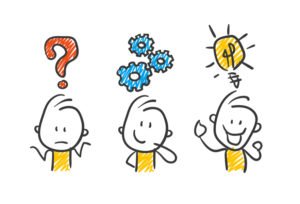by Amanda Robb, Senior Supervising Editor, Math
 As someone who received their education degree in the early 90s, I learned how to scaffold instruction for students. Our goals were to support their learning every step of the way and to remove any roadblocks to understanding our students might encounter. When providing direction instruction in our classrooms, we were taught to model a skill or strategy for our students, practice it together as a class, and then set students free to practice that skill or strategy on their own.
As someone who received their education degree in the early 90s, I learned how to scaffold instruction for students. Our goals were to support their learning every step of the way and to remove any roadblocks to understanding our students might encounter. When providing direction instruction in our classrooms, we were taught to model a skill or strategy for our students, practice it together as a class, and then set students free to practice that skill or strategy on their own.
Fast forward to years later, when I was no longer a classroom teacher, and when my son was attending elementary school. I heard his math teacher mention the concept of “productive struggle.” Over the years, educators encounter new buzzwords and shifts in educational theories and approaches. Differentiation…social emotional learning…synchronous and asynchronous learning. I had not yet heard of productive struggle, and I was intrigued.
According to the National Council of Teachers of Mathematics (NCTM), productive struggle allows students to dive “more deeply into understanding the mathematical structure of problems and relationships among mathematical ideas, instead of simply seeking correct solutions” (2014). So, what does productive struggle look like? In their book, Productive Math Struggle: A 6-Point Action Plan for Fostering Perseverance, SanGiovanni, Katt, and Dykema detail six steps for facilitating productive struggle with students: value, foster, build, plan, support, and reflect (2020). They describe how teachers can get to know their students as learners and build a classroom community where struggle is valued and is a normal part of learning.
As I dug deeper into the concept, I learned that when helping to facilitate productive struggle in their classrooms, teachers introduce a task or activity. The students engage in the activity, and then the class comes together to reflect on their experiences during the activity. As students complete the activity, they may struggle to decide upon and use an effective strategy or strategies, to find the correct answer, to communicate their reasoning, or even to know how to begin.
Educators can help students experience productive struggle by not jumping in to provide the correct answer or step-by-step directions for solving the problem. Rather, teachers can support students by helping them understand that struggle is a natural part of learning and by equipping them with strategies to value and work through struggle.
When engaging in a mathematical task, students can restate the problem in their own words, employ various strategies, ask questions of a fellow student or the teacher, learn what mathematical tools other students are using to complete the task, and focus on what the problem is truly about instead of merely trying to find the answer. For example, one strategy students can use to achieve this last goal is to remove the numbers from a word problem. By doing so, students can delve into making sense of the problem and what it is asking them to find instead of zeroing in on the numbers and quickly trying to calculate the answer. The aim is for students to be focused on the process (the journey) rather than the answer (the destination). A recent article from Edutopia explains the neuroscience behind productive struggle and points out that neural connections are built by “creating desirable difficulty through productive struggle” (2020). More evidence of the benefits of how productive struggle enhances learning is provided by Kapur, who states “Teaching that embraces and uses productive struggle leads to long-term benefits, with students more able to apply their learning to new problem situations” (2020).
Engaging in productive struggle helps students think critically about mathematics and their world at large, engage in a variety of strategies, and reflect on their learning process. As a parent, a retired educator, and one who works in the educational publishing field, I am excited to continue to delve into the many facets and benefits of productive struggle!
Subscribe to our blog
Categories
Related posts
Westchester K-12 Publishing Services Summit
by Kevin J. Gray, Managing Director, Westchester K-12 Publishing Services…
Marie’s Musings – May 2018
Thoughts on education, publishing, and other intellectual titillations – by Marie Brown,…
Truly Inspiring! The World of Math at NCTM
by Dave Bailis, STEM Content Director, Westchester K-12 Publishing Services…


